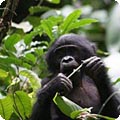présentation du projet ‘Ecological Bonobo Role project’ – jeudi 22 septembre 2011
 Le bonobo, jardinier de la forêt du Congo
Le bonobo, jardinier de la forêt du Congo
David Beaune, doctorant de l’équipe ECO/EVO, présentera ses découvertes sur le rôle inédit du bonobo dans l’écologie des forêt du Congo.
Rendez-vous le jeudi 22 septembre 2011 à 12 h 45, amphithéâtre Monge.
Résumé (en anglais, mais pas la conférence…)
In Congo basin, south of the Congo River the biggest primate and the sole representing of apes is the bonobo (Pan panisus). Population estimation of this threatened species fluctuates around 10.000 animals and its future is quite sombre. For bonobos as for the other primate the seed dispersal effectiveness (SDE) is not estimated so far. We still do not know what the relative importance of bonobo interaction is in the ecological network or, how many species need bonobo for reproducing? We still do not know what the dispersion efficiency is, in term of distance, seed number, viability, recruitment.
These factors are critical to many ecological questions as plant population dynamics, community structure and dynamics, recruitment limitation, gene flow, metapopulation dynamics, colonisation potential & plant migration in response to historic and future climate change, evolutionary trade-offs, maintenance of biodiversity, and more (Shupp et al. 2010). However the bridge between seed dispersion studies and forest ecology need to be crossed. In this study we try to bridge the gap, from the seed production to the forest population through the behaviour of one disperser: Pan paniscus.
- kc_data:
- a:8:{i:0;s:0:"";s:4:"mode";s:0:"";s:3:"css";s:0:"";s:9:"max_width";s:0:"";s:7:"classes";s:0:"";s:9:"thumbnail";s:0:"";s:9:"collapsed";s:0:"";s:9:"optimized";s:0:"";}
- kc_raw_content:
 Le bonobo, jardinier de la forêt du Congo
Le bonobo, jardinier de la forêt du CongoDavid Beaune, doctorant de l'équipe ECO/EVO, présentera ses découvertes sur le rôle inédit du bonobo dans l’écologie des forêt du Congo.
Rendez-vous le jeudi 22 septembre 2011 à 12 h 45, amphithéâtre Monge.
Résumé (en anglais, mais pas la conférence...)
In Congo basin, south of the Congo River the biggest primate and the sole representing of apes is the bonobo (Pan panisus). Population estimation of this threatened species fluctuates around 10.000 animals and its future is quite sombre. For bonobos as for the other primate the seed dispersal effectiveness (SDE) is not estimated so far. We still do not know what the relative importance of bonobo interaction is in the ecological network or, how many species need bonobo for reproducing? We still do not know what the dispersion efficiency is, in term of distance, seed number, viability, recruitment.
These factors are critical to many ecological questions as plant population dynamics, community structure and dynamics, recruitment limitation, gene flow, metapopulation dynamics, colonisation potential & plant migration in response to historic and future climate change, evolutionary trade-offs, maintenance of biodiversity, and more (Shupp et al. 2010). However the bridge between seed dispersion studies and forest ecology need to be crossed. In this study we try to bridge the gap, from the seed production to the forest population through the behaviour of one disperser: Pan paniscus.
